In Memorium: Steven Grant Kramer, 1953-2013.
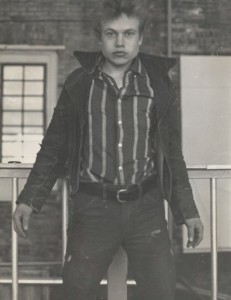 “How do, you do, Missus Willlley?” It is Ernest T. Bass’s doo-wop in Steven’s voice come from ethernity to wish me Happy Anniversary and in my mind’s car I’m driven to that mythical place, our Mayberry, a Coconino County outside-a Raleigh, an Enchanted Mesa just past Mt. Pilot, second star to the right, where everyone knows your brain.
“How do, you do, Missus Willlley?” It is Ernest T. Bass’s doo-wop in Steven’s voice come from ethernity to wish me Happy Anniversary and in my mind’s car I’m driven to that mythical place, our Mayberry, a Coconino County outside-a Raleigh, an Enchanted Mesa just past Mt. Pilot, second star to the right, where everyone knows your brain.
From 1969, when Duncan Hannah introduced us, until 1974, when I got and stayed gone, Minneapolis was our Petrified Forest version of Mayberry. Steven was Ernest, a brick-thrower like Ignatz mouse, my sister Min something of Charlene Darling/Krazy Kat, and my own self equal parts of Briscoe Darling (the hillbilly patriarch) and Dr. Y. Zowl. James Crosby was Officer B. “Cuddle” Pup. Roderick Gordon was Secret Squirrel; the Top Cat. Jim Clifford was Floyd but googlier. Duncan was Howard “Gooseberry” Sprigg – “The Duck Duke”. Dave “Grandpa” Forshtay, our favorite roommate, was equal parts Goober & Walter Cephus Austridge. Pam was Helen Heels. Bean was Thelma Woo Lou-Lou. Mary Kay Swelter was our own kinda Oppie &, sure, Nuff took us to the Catnip moon over the cardboard sea.
Steve was, like Ignatz Mice, a chronic hurler of metaphoric bricks & a romantic: “How do, you do, Missus Wiiiiley?” (“He’s a nut,” Barney concluded.) Occasionally I’d try to pass him off as my cousin, ‘Oliver Gossage from Raleigh’, at Moby Dick’s or Lyle’s Liquor. Liquor. Did it make us crazy or were we? As we approached high school graduation, it was an existential question of enormous importance. It’s solution, and our collusion, lay in art, which was less a noun than a verb and it took practice to make liquor soluble art.
Then art was an intoxicant, an accoutrement to intellectual and spiritual pursuits, an immersion in the senses toward a phenomenology of the mind that materialized as art, myth & literature. As boys will, we discombobulated. With the help of all the familiar intoxicants, we funked it up. We got down and stayed there, lived on the charcoal filtered aire full of reefer, pills, pianos, record players, hammers, nails, print, paint, a copious amount of Eggs Laredo and sheer hilarity. It was the sort of friendship you can barely maintain in your teens and twenties but sustains, til death do you part.
We were both sicker & thinner and dancing our Dionysian way through the theology of the early grave. The wonder real, of course, is that I’m alive. It seems by accident. “Too much booze, too many ‘ludes, too many movie magazines,” by which I mean the pulp fiction accidents. ‘Crazy Kramer’ was what my ‘merican graffiti friends, The ever sharp Sharks, in Hopkins, in the ‘burbs, called him. It was Steve, drunk, my main drag team pantsed for his much admired insubordination (they had a sense of humor); Who, lake party-drunk, wrapped us and the family station wagon round a tree and hid out in a swamp breathing through a hollow reed, a police flashlight passing over water; Who, country-drunk, could boogie-woogie ‘The Bear Went Over the Mountain’ all the sway into some pretty suburban girl’s way; Who, mean-drunk, could be kicked out of the Guthrie Theater, Lyle’s, Sutton’s, Moby Dicks’s, the Triangle, the 400, & Mousey’s all in one night; Who, tipsy, painted mice that’d enamor de Kooning; Who, hours before getting married the first time was hospitalized with self-inflicted 3rd degree burns; Who, Bowery-boy-drunk, got beat up by drunker Indians; Who, more drugged and still drunker, married once then again; Who, drunkest, fell off the roof on Christie St, NYC, doing, as he explained it to me, “sight-gags for punks,” and who sobered up sufficiently that once it was too late the Mayor declared it Steve Kramer Day in Minneapolis.
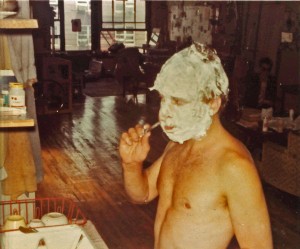 I was too drunk too but I wasn’t the stuff of legends. I wasn’t a musician, a painter, a sculptor, or a film-maker. I was a bookseller and occasional poet, by which I do not mean the kind that writes verses. Steve was a full-on artist. His brain made work, the personification of what the Greeks called Aretê. Mine was interested in “the communication between the inner being of things with the inner being of the human being”, what the Greeks called Sophia (I had a cat by the same name) on a poetic mission to a fool’s paradise (see: Mose Allison).
I was too drunk too but I wasn’t the stuff of legends. I wasn’t a musician, a painter, a sculptor, or a film-maker. I was a bookseller and occasional poet, by which I do not mean the kind that writes verses. Steve was a full-on artist. His brain made work, the personification of what the Greeks called Aretê. Mine was interested in “the communication between the inner being of things with the inner being of the human being”, what the Greeks called Sophia (I had a cat by the same name) on a poetic mission to a fool’s paradise (see: Mose Allison).
You may ask, “What is the poetic mission that starts back there in primary experience?” A complimentary one: Steve acted out and I contemplated. Once I watched him fuck in a tree over Lake of the Isles there was no question in my mind, without sharing limbs we were out on the same one. Dos caballeros extraño. Hence, in youph, we could hardly do without one another. 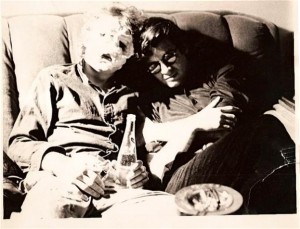
Of course, I’m being facetious, which is what we were known for. In 1972, when I returned to Minneapolis from my San Francisco hippy-trip, our occasional flops turned into equal shares in several low dives before settling in the infamous 22nd Street storefront where we pursued the art of the unreal in full pants-down view of the public, like nobody’s business. I’d got over being a yoga practicing, zazen sitting, macrobiotic semi-detached lapsed Catholic mystic j.d. from Cheesetown (Hopkins) with a Trisha Nixon hairdo and my mind was full of ‘Pataphysics; imaginary solutions to problems I shared with nobody in a deeper and larger sense than Kramer.
Anyone else I usually had to explain these things to in ways I found tedious. There was nothing usual or tedious about Steve. He induced me to confront reality with art; I scrutinized the universal implications. He art; I poetry. He represented the loco; I the logos. We, inebriation. It was quite a performance and, though much was destroyed in the process (Dada) there is an incredible body of work to show for it. In Minneapolis, I produced a poorly written juvenalia that still makes me laff and Steve painted a large body of work some Europeans call Art Brut and American’s Abstract Expressionism, better yet Action Painting, excelling at something most people can’t do after 9 years old. It was Dubuffet with a torch, all day, all the way. He was crooning De Kooning.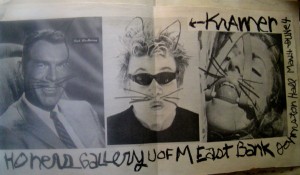 What women were to De Kooning, mice were to Kramer. It started with the pair of rodents he gave me for my birthday, Ron of Japan (named for a restaurant in Chicago) and the gifted Senorita O’Toole (see: Quickdraw McGraw), who begat enough rats to start an art movement. Steve gifted me with animals. If you’ve ever tried gifting a friend with animals you know what a tricky business this can be. Knowing I liked cats – not that he did – there were Old Ted and Mikey (Mother & Daughter), Alan the Stick’em Cat, Ronald Coleman (see list at right) – 15 all told, monitoring 75 usually caged rats in the 22nd Street store fronts. There were mornings we’d wake to little pyramids, just the snout and whiskers, that were all the cats left of the escapees. We made bigger better cages: bemusement parks with circus tricks. We daily entertained Frank, an autistic street evangelist who stole bikes for a living, and his sidekick, Gert, an ex-nun with the Tourette’s symptom of swearing angry and groddy in flagrant derelicto. Was the other guy’s name Red Eagle or Rodriguez? Dipso coot Bill tipped off his stool for the last time while playing The Blue Skirt Waltz on the accordion, which inspired Steve! A small aircraft and Calder-esque rodent sculptures hung from the ceiling. You climbed a 12 ft. ladder to use the bathroom. My grandparents, Tony and Jose Pogerlc of Holdingford (a.k.a. Lake Woebegone), thought we lived like “primates.” My parents forbade my sister Min to visit. She disobeyed.
What women were to De Kooning, mice were to Kramer. It started with the pair of rodents he gave me for my birthday, Ron of Japan (named for a restaurant in Chicago) and the gifted Senorita O’Toole (see: Quickdraw McGraw), who begat enough rats to start an art movement. Steve gifted me with animals. If you’ve ever tried gifting a friend with animals you know what a tricky business this can be. Knowing I liked cats – not that he did – there were Old Ted and Mikey (Mother & Daughter), Alan the Stick’em Cat, Ronald Coleman (see list at right) – 15 all told, monitoring 75 usually caged rats in the 22nd Street store fronts. There were mornings we’d wake to little pyramids, just the snout and whiskers, that were all the cats left of the escapees. We made bigger better cages: bemusement parks with circus tricks. We daily entertained Frank, an autistic street evangelist who stole bikes for a living, and his sidekick, Gert, an ex-nun with the Tourette’s symptom of swearing angry and groddy in flagrant derelicto. Was the other guy’s name Red Eagle or Rodriguez? Dipso coot Bill tipped off his stool for the last time while playing The Blue Skirt Waltz on the accordion, which inspired Steve! A small aircraft and Calder-esque rodent sculptures hung from the ceiling. You climbed a 12 ft. ladder to use the bathroom. My grandparents, Tony and Jose Pogerlc of Holdingford (a.k.a. Lake Woebegone), thought we lived like “primates.” My parents forbade my sister Min to visit. She disobeyed.
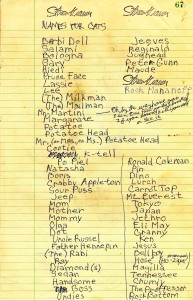 “How do you do, Mrs. Wiley?” Little did I then suspect Steve’s plan. Ernest T. Bass knocked out his three front teeth and put a gold one in the center, leaving a space on each side “…So it’ll stand out better that way, ‘specially when I’m dancing.” That was how Ernest T, whose tooth was gold leaf and done by a sign company in Raleigh, explained it. Steve’s, done on welfare, wasn’t far off. He fell off the building looking like Marlon Brando. When he got out the hospital, after his “recent unpleasantness,” he looked like Lester Young with the mumps. Which is to say pained. And what did he do so…?
“How do you do, Mrs. Wiley?” Little did I then suspect Steve’s plan. Ernest T. Bass knocked out his three front teeth and put a gold one in the center, leaving a space on each side “…So it’ll stand out better that way, ‘specially when I’m dancing.” That was how Ernest T, whose tooth was gold leaf and done by a sign company in Raleigh, explained it. Steve’s, done on welfare, wasn’t far off. He fell off the building looking like Marlon Brando. When he got out the hospital, after his “recent unpleasantness,” he looked like Lester Young with the mumps. Which is to say pained. And what did he do so…?
I saw him in the fallen angel Keith Haring, my next favorite artist of the time, drew in transit (full disclosure: a plug for our book Art in Transit: The Subway Drawings of Keith Haring). Everything I learned about art from Steve in the years we lived together in the 70s was what I’ve essentially needed to know about art ever since.
Which is what? you reasonably ask. Art is in the making. In the making it up. It’s in the materials but not in the material. Art is, ironically, what can’t be bought, doesn’t translate, and – pretentious as it may sound – you had to be there at the moment of creation or you missed it. The rest is icing and usually far too sugary.
The East Village-post-Warhol-punk aesthetic was puerile/twee after the summer of ’73 in Minneapolis, when art walked and talked and danced and drank and smoked and joked us existential as nobody’s business. We made a transcendent debacle of a spectacle of ourselves. With me it was mostly the spectacles. With Steven it was straight up spectacular. Spectators, who mistook his art as being something like an extreme sport, somehow managed to pervert that which was already perverted. To them his Art was a noun, the college-educated school of …, the stuff, the brand, the pose, the life style, to be consumed. It’s not an interpretation but a fetish.
Fetishism is not Perversion. Perversion is, of course, essential to the creative process, which is essentially subversive of the common denominators we know to be “such a bore”. Worshiping fetishes bores. Not all perverts are artists but all artists are perverts, particularly the most conventional. Art can, and needs, unmake things up. Like fetishes but not.
Which brings us back to Our Mayberry. ‘What did you birds see in The Andy Griffith Show?’ you ask. What we saw was when what you can make up un-happens what’s happened. As If. Un-Mayberrying Minneapolis we were doing the same, in reverse. We were not acting ironic, we were. White boys with black thoughts, keeping black time in the wrong part of a white town, on purpose.
We lived jazz: ragtime, Dixieland, blues, swing, pre-bop, bebop, hard-bop, cool-school, free and fusion was all amusin’. I can’t hear Rahsaan Roland Kirk with Al Hibbler or his Volunteered Slavery without Steve being here but for that matter jazz itself is the madeleine. Art is Tatum. Who else can I say that about? Earl Hines. We revered Earl Hines, particularly with Marva Josie, and Thelonious Monk. I once talked to Monk on the phone (he was listed in the Manhattan phone book when we had the loft on 14th Street) and tasted it in the timbre of his voice. Monk and Steven convinced me I could see what I hear. Some other spring Steve took me to Theolonius Sphere Monk Circle, the cul-de-sac of West 66th St. behind Lincoln Center, to see where the Master lived and listened and San Juan Hill took us by storm. We acted jazz, to us the measure of all measures, as best we could. Ours was a Through the Looking Glass world, an X-ray vision of The Palm Wine Drinkard in the Bush of Ghosts, and where we still meet whenever & wherever jazz happens.
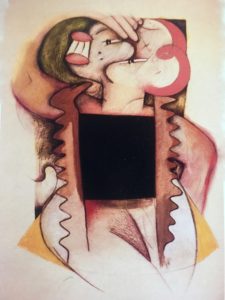 I own one Kramer, a very good one featured in Steve Hager’s Art After Midnight, therein mistitled X-Ray and misdated 1985. It is The Empress’s New Clothes and from 1982, the first show at the second Mrs. Kramer’s Fun Gallery, at which point I’d been watching him create for a decade. I didn’t watch him paint this one; it wasn’t painted but illuminated which gave it all the more appeal. I hoped he was evolving instead of disintegrating. New York was killing him. Still, the circumstances were auspicious. It’s painted in the Central Park West apartment of rare book dealer Gunnar Kaldewey. When we parted company, this Gunnar became Steve’s patron. Years later he’d be my patron in procuring my present, his former, abode in Harlem. This was unbeknownst to any of us until years later it all came out at James Crosby’s memorial, at which point we were unbeknownst to each other sufficiently so that it took, after 20 years, ten minutes to catch up and he & me were we, together again.
I own one Kramer, a very good one featured in Steve Hager’s Art After Midnight, therein mistitled X-Ray and misdated 1985. It is The Empress’s New Clothes and from 1982, the first show at the second Mrs. Kramer’s Fun Gallery, at which point I’d been watching him create for a decade. I didn’t watch him paint this one; it wasn’t painted but illuminated which gave it all the more appeal. I hoped he was evolving instead of disintegrating. New York was killing him. Still, the circumstances were auspicious. It’s painted in the Central Park West apartment of rare book dealer Gunnar Kaldewey. When we parted company, this Gunnar became Steve’s patron. Years later he’d be my patron in procuring my present, his former, abode in Harlem. This was unbeknownst to any of us until years later it all came out at James Crosby’s memorial, at which point we were unbeknownst to each other sufficiently so that it took, after 20 years, ten minutes to catch up and he & me were we, together again.
I owe Kramer more than I own. Not only for the painting, for which I may have paid dope money, but for painting and plastering Our Town. We got each other out of Our Town, which I found stifling, and to the big bright city lights. Where so many go so wrong, things have turned out alright for me. It’s a heady place and it can go to your head, which I found easier to come by here. In the big town you can turn around, one day to the next, and have a new circle of jerks, then another, and it don’t stop.
We stopped being close when he wouldn’t, couldn’t, stop what he shouldn’t, along with what he should have. In New York he gradually stopped painting. First there were the infamous “boxes,” animating his plastered menagerie. Then his own highly combustible jazz punked-out where it had funked-out, reducing him to alt-rock. Dude had rhythm. But the fame bug bit ‘im bad as the dope did and he took to running with wannabes to where he shouldn’ta been. He never should have thrown in with such white goys. I got to deplore rock & roll, at least the glitter-trite, dressed up like…, posing too hard for pictures, sortamental, bovine decadent bourgeois “don’t hate me because I’m beautiful” rawther anti-intellectual neurotic suburban liber-teen thing, that bad habit scene that egged-on “Krazy Kramer” until, Kramer vs. Kramer, he lost his way.
“You just fight for your life,” as cool Lester Young used to say, and Steve knew it. He fell off the edge of the whirl, went back to cold (sub-zero as I write this) Minneinapolis (where Lester grew up), cleaned up, got himself some religion, found himself a hot room, some loose shoes, and a warm place to became a successful commercial artist/musician. Which is not to say rehab was bad for him. I still loved him and I still do.
Now he’s done got over it & I bet it’s wonderful there.
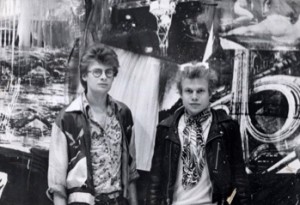 Me & Steve with Robert Rauschenberg. Walker Art Center. 1972.
Me & Steve with Robert Rauschenberg. Walker Art Center. 1972.
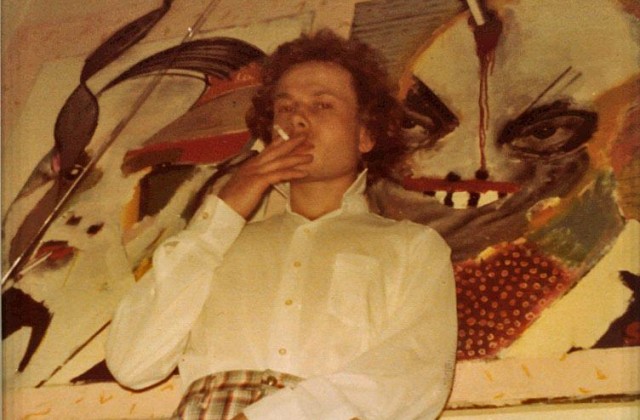
 Jumel Terrace B&B
Jumel Terrace B&B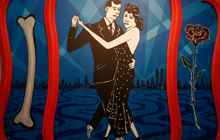 Life Turns Man Up & Down
Life Turns Man Up & Down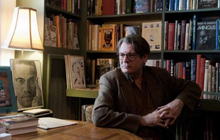 The Private Library
The Private Library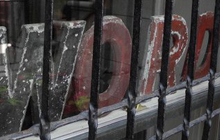
Very nice, Kurt